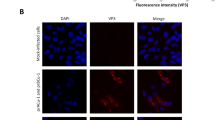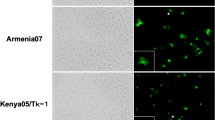Abstract
Avian erythroblastosis virus (AEV) induces a fatal erythroblastosis within 2 weeks of intravenous injection in chicks in virtually 100% of cases. In chicks injected intramuscularly, sarcomas frequently develop at the site of injection before the animals die from erythroblastosis1. In vitro, AEV transforms both erythroblasts, derived from bone marrow cultures, and fibroblasts. These effects have been shown to be a general property of AEV and not of separate leukaemia- and sarcoma-inducing forms of the virus2. AEV is defective for replication and can be propagated only in the presence of helper virus. Its transformation specificity is independent of the helper virus used2. It is not clear whether AEV has two different genes controlling transformation of the two types of target cell or whether it has only one gene coding for both. To investigate this question, we looked for mutants of AEV unable to transform one of the two types of target cell. We now describe such a mutant, which is defective for erythroblast transformation but which can still transform fibroblasts.
This is a preview of subscription content, access via your institution
Access options
Subscribe to this journal
Receive 51 print issues and online access
$199.00 per year
only $3.90 per issue
Buy this article
- Purchase on Springer Link
- Instant access to full article PDF
Prices may be subject to local taxes which are calculated during checkout
Similar content being viewed by others
References
Graf, T., Fink, D., Beug, H. & Royer-Pokora, B. Cancer Res. 37, 59–63 (1977).
Graf, T., Royer-Pokora, B. & Beug, H. Virology 71, 423–433 (1976).
Graf, T. Virology 50, 567–578 (1972).
Hayman, M., Royer-Pokora, B. & Graf, T. Virology 98, 191–199 (1979).
Dodge, W. H. & Moscovici, C. J. cell. Physiol. 81, 317–386 (1973).
Graf, T. et al. Virology 83, 96–109 (1977).
Stéhelin, D., Saule, S., Roussel, M., Lagrou, C. & Rommens, Cold Spring Harb. Symp. quant. Biol. 44 (in the press).
Royer-Pokora, B. et al. Cell 13, 751–760 (1978).
Graf, T., Ade, N. & Beug, H. Nature 257, 496–501 (1978).
Graf, T., Beug, H., von Kirchbach, A. & Hayman, M. Cold Spring Harb. Symp. quant. Biol. 44 (in the press).
Hanafusa, H., Halpern, C. C., Buchhagen, D. L. & Kawai, S. J. exp. Med. 146, 1735–1747 (1977).
Stéhelin, D., Varmus, H., Bishop, J. M. & Vogt, P. K. Nature 260, 170–173 (1976).
Roussel, M. et al. Nature 281, 452–455 (1979).
Blug, H. V., Kirchbach, A., Dolderlein, G., Conscience, J. F. & Graf, T. Cell 18, 375–390 (1979).
Author information
Authors and Affiliations
Rights and permissions
About this article
Cite this article
Royer-Pokora, B., Grieser, S., Beug, H. et al. Mutant avian erythroblastosis virus with restricted target cell specificity. Nature 282, 750–752 (1979). https://doi.org/10.1038/282750a0
Received:
Accepted:
Issue Date:
DOI: https://doi.org/10.1038/282750a0
This article is cited by
Comments
By submitting a comment you agree to abide by our Terms and Community Guidelines. If you find something abusive or that does not comply with our terms or guidelines please flag it as inappropriate.



